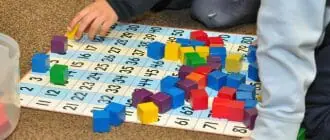Task cards are a great way to keep students engaged and on-task. Cards are particularly useful for allowing students to customize their learning by assigning task cards that are relevant to a particular student’s interests and abilities.

What are task cards? Quite simply, task cards are cards with tasks on them! Many teachers use task cards as alternatives to worksheets or other, more traditional classroom activities. Students often prefer task cards over worksheets because they are more interactive, encouraging hands-on learning and collaboration.
How do You Make Task Cards?
There are many different ways to make task cards. You can make them with computer software such as Microsoft Word, PowerPoint, or Publisher.
This tutorial provides step-by-step instructions for making task cards using Microsoft PowerPoint. Task cards can also be made by hand with index cards and markers. No matter how you make your task cards, the most important thing to remember is to make them fun and colorful to capture your students’ interest. It’s also a good idea to laminate your cards; as students use the cards and pass them around, it’s very easy for them to get worn, torn, and dirty if they aren’t laminated.
How do You Make Digital Task Cards for Google Forms?
If you’re a digital aficionado, this tutorial will show you how to make interactive cards using Google Forms. Students can view and use these cards electronically. You can even set them up so that Google Forms will assess and grade the students’ work for you!
For classroom use, I’ve collected 26 of the most exciting task card ideas. Read below!
26 Ways How to Use Cards in the Classroom
Let’s take a look at some specific ways in which task cards can be a great addition to your classroom.
- Connect 4 →
- Warm-up →
- Scoot →
- For Fast Finishers →
- In a Scavenger Hunt →
- Quiz, Quiz, Trade →
- Boom Cards →
- Parent Helpers →
- As Morning Work →
- With Whiteboards →
- As Assessment →
- With Partners →
- In Small Groups →
- Test Prep →
- Homework →
- Guided Reading Group →
- Review Game →
- Task Cards as Centers →
- Transition →
- Sub Plans →
- Task Cards as Hide and Seek →
- Record the Progress of Your Students →
- Board Games →
- Jeopardy →
- Speed Mathing →
- Literacy Stations →
Read on to learn more about each of these methods!
1. Connect 4
Age: elementary and middle school
Subjects: math
Connect 4 is a game similar to Tic Tac Toe. Students drop plastic discs into the game board. Whoever gets four of their color in a row first wins. This game can easily be incorporated into a task card activity by having students solve math problems to earn a chance to play one of their game pieces.

To do this, make various task cards with grade-level-appropriate math problems. In pairs, students will take turns solving the problems. If the student answers correctly, they play one of their game pieces. Partners will take turns until one of them gets four of their pieces in a row.
If you don’t currently have Connect 4 boards in your classroom, you can purchase some or have your students play online here.
2. Warm-up
Age: elementary, middle, or high school
Subjects: math, English/reading, social studies, science, foreign language
Sometimes, it takes students a little while to get ready for a new day. You can use task cards to help them warm up at the beginning of class.

Create a stack of task cards that relate to the subject matter that you teach. Cards can involve solving problems, answering a writing prompt, discussing something with a partner, or any other activity that gets them thinking. You can hand out one card to each student or choose one for the entire class to complete. This allows for some variety in your warm-up activities while helping the students’ minds prepare for learning.
3. Scoot
Age: elementary and middle school
Subjects: math, English/reading, social studies, science, foreign language
Scoot is a fun activity that gets students up and moving! Many younger learners have trouble staying still throughout a lesson, so Scoot is a great way to keep them focused while letting them move around the room.

You should create enough task cards on a specific topic for each student. Number the cards and place them around the room (you can also simply place one on each desk). Each student begins by completing the task on the card in front of them. If the cards involve answering specific questions, answers can be recorded on a sheet. When everyone is done, signal the students to move to the next card (they should move in numerical order). Keep going until every student has completed each card. Read more about this game in this article.
4. For Fast Finishers
Age: elementary, middle, and high school
Subjects: math, English/reading, social studies, science, foreign language
Every student works at a different pace. If some students finish before others, it can be boring for the fast finishers and stressful for those who take more time. Task cards can help keep everyone engaged.

Each student should have several task cards on their desk. When students are working independently, instruct them to begin working on the tasks on their cards if they finish while others are still working. These tasks should be aimed at enrichment and reinforcing concepts. Students who work more slowly shouldn’t be penalized if they don’t complete any cards.
5. In a Scavenger Hunt
Age: elementary and middle school
Subjects: math, English/reading, social studies, science, foreign language
A scavenger hunt is another great way to get students out of their chairs! This activity is one of the easiest ways to include task cards in your lesson.

Begin by hiding a variety of task cards around the room. Students can work alone or in pairs to search the room for the cards. When they find a card, they should complete the question or activity and record the answer. Keep going until each student completes every card.
6. Quiz, Quiz, Trade
Age: elementary, middle, and high school
Subjects: math, English/reading, social studies, science, foreign language
Sometimes, being the teacher is the best way to learn. That’s the premise of Quiz, Quiz, Trade.

Begin by giving each student a task card. Students should then pair up. Student One asks the question on their card, and Student Two tries to answer. Then, they switch roles. Once both students have asked and answered a question, they should find new partners and repeat the process.
7. Boom Cards
Age: elementary and middle school
Subjects: math, English/reading, social studies, science, foreign language
Boom Cards are a great way to include digital activities in your classroom. Many students are more comfortable with digital content, so Boom Cards really capture their interest!

Boom Cards are digital, interactive task cards. You can create as many cards as you want on any subject. Students can log onto a device and move through the task cards at their own pace. They get instant feedback on their performance and you can check-in and see how well they did.
8. Parent Helpers
Age: elementary, middle, and high school
Subjects: math, English/reading, social studies, science, foreign language
Students learn best when concepts are reinforced at home. You can help parents work with their kids with at-home task cards!

Many parents want to help their kids learn but aren’t sure how to do it. Create task cards that students can take home. Parents can work with their kids on the task cards, getting them involved in the child’s learning and reinforcing concepts covered in school.
9. As Morning Work
Age: elementary, middle, and high school
Subjects: math, English/reading, social studies, science, foreign language
It isn’t always easy to get student-focused at the beginning of the day. Task cards can help tune them in and get them focused.

Each morning or at the beginning of your class, display a task card using a portable document camera or projector. As students filter into the classroom, they can begin working on the task. Each day’s task should help them warm-up for the lesson and get ready to focus on the concepts that will be covered.
10. With Whiteboards
Age: elementary, middle, and high school
Subjects: math, English/reading, social studies, science, foreign language
If you’re looking to make your classroom a little greener, using task cards with whiteboards is a great way to cut down on paper waste.

Begin by handing each student a whiteboard and dry erase marker. Display task cards one at a time using a document camera or projector. Students can answer the questions on their individual boards. Once you’ve given feedback, they can erase their answers and get ready for the next card.
11. As Assessment
Age: elementary, middle, and high school
Subjects: math, English/reading, social studies, science, foreign language
Are you looking for a way to assess your students’ knowledge without the pressure of a test or quiz? Try task cards instead!

Creating task cards for new content is a great way to get a feel for how well students are grasping the material. Cards can be completed as a whole group, with students answering on paper or whiteboards. You can also have students work alone or with partners. If students perform the tasks well, you know that they’re ready to move on to more complex material.
12. With Partners
Age: middle and high school
Subjects: math, English/reading, social studies, science, foreign language
Collaborative learning is one of the best ways for students to master material. Try pairing students up while using task cards.

In this activity, each student can have one card or several. Partners should take turns reading the cards and asking their partner to complete the task. This allows peers to give each other feedback, which helps both of them learn with less pressure.
13. In Small Groups
Age: high school
Subjects: English/reading, social studies, science
Two heads are better than one, and even more brains are even better! For complex tasks that require a bit of discussion, try using task cards in groups.

Students should be divided up into groups of three or more. Each group is given a card with a complex question, scenario, or discussion topic. Groups should work together to discuss all aspects of the task and come to a consensus on the best solution.
14. Test Prep
Age: elementary, middle, and high school
Subjects: math, English/reading, social studies, science, foreign language
Preparing for a test can be daunting, but everyone loves a good review game! Try using task cards to get your students ready for an upcoming exam.

Prepare task cards that review and reinforce topics that will be covered on the test. Students can complete tasks alone, in pairs, in small groups, or as a whole class. The important thing is that students are able to get immediate feedback on their performance, so they know what material they still need to work on before test time.
15. Homework
Age: elementary and middle school
Subjects: math, English/reading, social studies, science, foreign language
Who says task cards have to stay in the classroom? Make homework more engaging by sending task cards home!

Students can be given several task cards to take home and complete on their own. Have them record their answers on paper so that the next day, you can provide feedback on their performance. This is a great way to get out of the textbook rut.
16. Guided Reading Group
Age: elementary, middle, and high school
Subjects: Reading, English, language arts
Reading a book or story isn’t just about scanning the words on the page. Use task cards to help students think about the content in a guided reading group.

After students have read a text, put them in groups to discuss the reading. Provide each group with a set of task cards to help them analyze the reading. Younger readers can receive basic questions about plot, setting, and characters, while older readers can explore more complex topics like themes and symbolism. Task cards a great way to encourage students to share their thoughts and opinions.
17. Review Game
Age: elementary, middle, and high school
Subjects: math, English/reading, social studies, science, foreign language
Everyone knows that reviewing concepts is more fun if there’s a little competition! You can use task cards to create fun and engaging review games before a test or any time that you want to assess learning.

Put students into teams and share task cards one at a time with a document camera or projector. The first team to come up with the correct answer gets the point!
18. Task Cards as Centers
Age: elementary school
Subjects: math, English/reading, social studies, science, foreign language
Get younger learners up and moving by using task cards to create classroom centers.

Elementary students often use centers to engage in different topics in different parts of the room. Changing location helps them focus their mind in the right direction. Try creating different centers around the room with task cards focused on a specific subject or topic.
19. Transition
Age: elementary, middle, and high school
Subjects: math, English/reading, social studies, science, foreign language
Moving from one topic to another can be difficult. Help students stay focused and on task with transition flash cards.

Similar to warm-ups, transition activities help students redirect their thinking to get ready for the next topic. Try developing task cards that ease the students from one topic to another and deploy the cards when it’s time to switch topics.
20. Sub Plans
Age: elementary, middle, and high school
Subjects: math, English/reading, social studies, science, foreign language
Everyone needs a day off now and then. Keep your students learning by leaving task cards for your substitute.

When you have a sub, it’s easy to fall back on busywork that does little to engage the students in their learning. However, if you have task cards prepared, your sub can easily guide students through relevant activities that actually make good use of your day off!
21. Task Cards as Hide and Seek
Age: elementary school
Subjects: math, English/reading, social studies, science, foreign language
Like an Easter egg hunt, hunting for task cards is a great way to get students up and moving!

Instead of handing out task cards for students to work on, hide the cards around the room before they arrive! Students will have to search the room for cards before they perform the task, turning learning into a fun game.
22. Record the Progress of Your Students
Age: elementary, middle, and high school
Subjects: math, English/reading, social studies, science, foreign language
Tests and quizzes are a lot of pressure. Try replacing them with task cards!

Instead of creating a written test for students to take, give them a set of task cards to perform. Students can record their answers on paper so you can still assess their learning.
23. Board Games
Age: elementary school
Subjects: math, English/reading, social studies, science, foreign language
Task cards can be combined with just about any board game to reinforce learning while still having fun! Here you may find lots of board games.

Students should play games in pairs or groups. Each group will have a stack of task cards. Before they can take their turn, they must correctly answer the question on the card.
24. Jeopardy
Age: middle and high school
Subjects: math, English/reading, social studies, science, foreign language
Task cards in different categories can be used to create a unique Jeopardy-style game!

Create a Jeopardy board by writing categories on the board. Place task cards that match the categories below with varying point levels. Students can earn points by answering the questions on the cards.
25. Speed Mathing
Age: elementary school
Subjects: math
Speed mathing is often a dreaded activity. Make it fun with task cards! Learn all about this activity in this video:
Speed mathing requires students to answer basic math problems as quickly as possible to help them develop their computation skills. Instead of worksheets, give students task cards that they can use to quickly move through the problems in a more interactive way.
26. Literacy Stations
Age: elementary
Subjects: English, reading, literacy
Reading and writing are multi-faceted subjects. Use task cards to create literacy stations and school libraries and make learning easier and more interactive.

Create task cards focused on specific literacy topics, such as characters, settings, nouns, verbs, etc. Students should move around the room to different stations to practice the different concepts that they’ve been working on.
In Conclusion
Often, students are more inclined to focus on a lesson if activities are interactive. Task cards a great way to get them engaged in a lesson! Cards can be used in just about every subject and grade level. The above ideas are a great starting place for figuring out how to incorporate fun task cards into your lessons to help students take ownership of their learning!
Last Updated on February 21, 2022 by Emily
- Facebook9
- Twitter21
- Pinterest67
- 97shares




